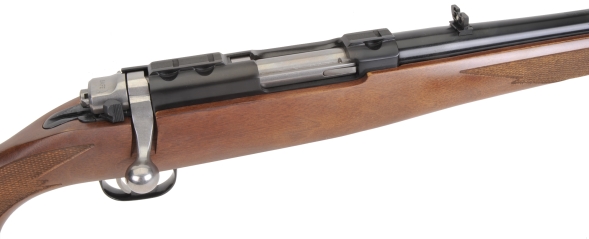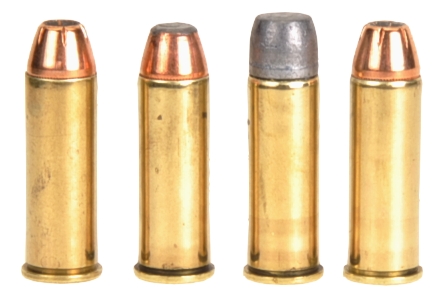
After defining the Ruger Model 77/44 in part one, it seemed a demonstration was in order, a demonstration with ammunition suitable for hunting medium to larger game. Four component bullets were selected, all within a weight range of 240 grains to 300 grains, three are lead core jacketed and one hard cast lead alloy. The 270 grain Speer and 275 grain Cast Performance are intended for game heavier than deer, as determined by bullet construction and bullet manufacturer’s recommendations.The heaviest bullet, the 300 grain Hornady, is intended for deer and other game with a body weight of 300 pounds and under. A 240 grain hollow point cast was originally selected for the low end, but it was soft lead and without a gas check. The concern was that excessive leading an gas cutting at elevated velocity.

| Bullet | Bullet Type |
Bullet Weight Grains |
Bullet Length “ |
Cartridge Overall Length “ |
| Hornady HP/XTP | JHP | 240 | 0.707 | 1.600 |
| Speer Deep Curl | JSP | 270 | 0.770 | 1.595 |
| Cast Performance | Hard Cast | 275 | 0.742 | 1.655 |
| Hornady HP/XTP | JHP | 300 | 0.860 | 1.600 |

Handloads were constructed with once fired brass. All bullet have cannelures and all rounds were roll crimped, not so much as a requirement for the Ruger Model 77/44, but because there is a parallel article being written using the same ammunition in a revolver. All rounds were at or below the 1.610″ SAAMI spec cartridge overall length, with the exception of the Cast Performance assemblies. They exceeded maximum of cartridge overall length by 0.045″, but had no problem feeding from the Ruger’s magazine or chambering without leade interference.
The Cast Performance bullet’s geometry is something to consider. It is often said that cast bullets of a given weight can take a greater charge than a jacketed counterpart; incredibly creative theories then follow. I would suggest that lead cast bullets are more dense than jacketed/lead composites. Therefore they are shorter, protrude into the cartridge case yet and have a greater net case capacity, which requires an increase in powder charge in comparison to a jacketed bullet of comparable weight.
A little head scratching, a little research, a little calculating… then some shooting
If pressure barrels are not available and a strain gauge can’t be mounted research and calculations determine starting loads. Research means sourcing several generations and sources of handloading manuals to do a sanity check on calculations. Then starting loads are increased until signs of excessive pressure develop; excess velocity, excess report, fired cases appearance or expansion suggests taffy, or until accuracy falls off. The 44 Magnum should not operate at a pressure level that causes blown primers, sticky bolts, hard extractions, or bolt face stamped case heads. If anything was other than pedestrian in the handload exercise, it would be that forecasted velocity was uniformly within a few fps of actual recorded.
Warning: Bullet selections are specific, and loads are not valid with substitutions of different bullets of the same weight. Variations in bullet material and length will alter net case capacity, pressure and velocity results. Primer selection is specific and primer types are not interchangeable. These data represents maximum loads in our firearms and test equipment and may easily be excessive in other applications. All loads should be reduced by 3%, and developed following safe handloading practices as represented in established reloading manuals produced by component manufacturers. Presentation of these loads does not constitute a solicitation for their use, nor a recommendation. Frogs are almost always green and say “Rivet”.
| COL and Capacity | Load Data & Performance | |||||||||
| Bullet | Type | Bullet Weight |
C.O.L. Inches |
Net Grains Water |
Powder | Charge Grains |
Muzzle Velocity FPS |
Muzzle Energy Ft/Lbs |
100 Yard Group Size “ |
|
| Hornady HP/XTP | JHP | 240 | 1.600 | 25.5 | H110 | 25.0 | 1850 | 1824 | 1.50 |
|
| Hornady HP/XTP | JHP | 240 | 1.600 | 25.5 | W296 | 25.0 | 1866 | 1856 | 1.25 |
|
| Speer Deep Curl | JSP | 270 | 1.585 | 22.7 | H110 | 22.5 | 1657 | 1647 | 1.60 | |
| Speer Deep Curl | JSP | 270 | 1.585 | 22.7 | W296 | 23.0 | 1685 | 1703 | 1.70 | |
| Cast Performance | WFNPB | 275 | 1.655 | 26.3 | H110 | 24.0 | 1801 | 1981 | 1.20 | |
| Cast Performance | WFNPB | 275 | 1.655 | 26.3 | W296 | 23.5 | 1769 | 1911 | 1.10 | |
| Hornady HP/XTP | JHP | 300 | 1.600 | 19.9 | H110 | 20.0 | 1524 | 1548 | 1.6 | |
| Hornady HP/XTP | JHP | 300 | 1.600 | 19.9 | W296 | 20.0 | 1544 | 1588 | 1.3 | |
OK, so I shot 50 yard groups with open sites to prove the Ruger’s woodland worth and it was fun, but clearly not reflective of the rifle’s potential. The front sight brass bead is 0.065″ is diameter, which is appropriate, but I am a Fire Sight stage of life… so 1 1/2″ to 2″ was the best I could do. I slapped on a scope, cranked it up to 9x and shot the 100 yard groups that appear on the table while getting most of the influence of my eye balls out of the equation. Is greater precision possible? I’m sure as these are less than adventurous handloads using two down and dirty powder selections.
Friday morning illation…
Accurate 4100, Alliant 2400, Hodgdon Lil’ Gun, IMR 4227 are all good powder types that might serve increased velocity and diminished group sizes. Certainly there are other bullets and combinations of components. For me, the accuracy and velocity levels are ready to go as posted. The rifle is light, barely edging over 5 lbs, and it does kick a little. Not the prolonged agony of a shoulder stretching magnum, but just a quick, sharp rap on the shoulder to let you know the 44 mag has hog, deer and black bear killing power… and then some.
Some folks may prefer low maintenance stainless steel hardware and synthetic stock over the walnut and blue. Some folks might even prefer 357 Mag versions. Whichever the personal preference, it is a product worth a look.

Email Notification